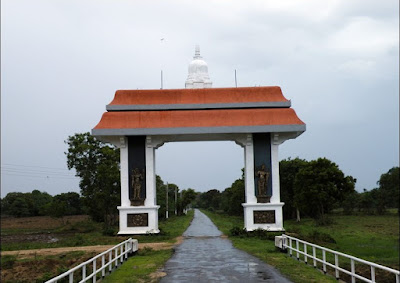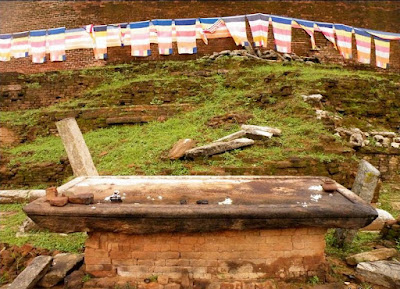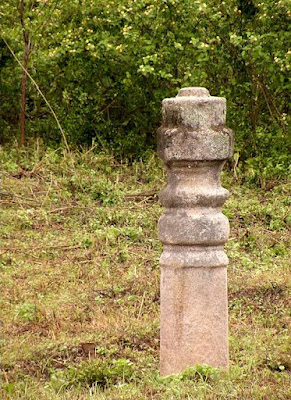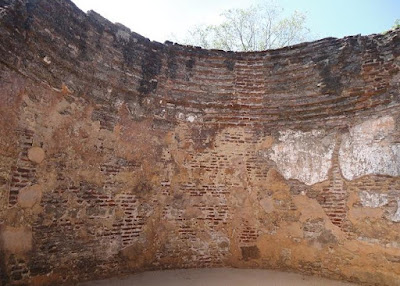Nilneth Sri Lanka
Monday, July 20, 2015
Tuesday, July 8, 2014
Wednesday, September 25, 2013
Tuesday, May 28, 2013
Sunday, March 31, 2013
Deegavapi (Digavapi) Stupa -Ampara
 According to the the Mahavansa, great chronicle of Sri
Lanka, this stupa was built by king Saddhatissa (137-119 BC). According to the
same the king has also donated a jacket decorated with gold lotus flowers and
various gems to cover the stupa.
According to the the Mahavansa, great chronicle of Sri
Lanka, this stupa was built by king Saddhatissa (137-119 BC). According to the
same the king has also donated a jacket decorated with gold lotus flowers and
various gems to cover the stupa.
...... "Moreover, he founded the Dighavapi-vihara
together with the cetiya; for this cetiya he had a covering of network made set
with gems, and in every mesh thereof was hung a splendid flower of gold, large
as a wagon-wheel, that he had commanded them to fashion. (In honour) of the
eighty-four thousand sections of the dhamma the ruler commanded also
eighty-four thousand offerings. When the king had thus accomplished many works
of merit he was reborn, after his death, among the Tusita gods.”...........
 Since this location has been blessed by Buddha's presence,
it is generally believed that this stupa is a "paribogika" stupa and
no special relics have been enshrined. But historian venerable Ellawela
Medananda thero believes that this stupa enshrines a nail relic of Buddha. An
inscription on a gold foil unearthed during excavations discloses that King
Kawanthissa (164-192) has done renovations to the stupa.
Since this location has been blessed by Buddha's presence,
it is generally believed that this stupa is a "paribogika" stupa and
no special relics have been enshrined. But historian venerable Ellawela
Medananda thero believes that this stupa enshrines a nail relic of Buddha. An
inscription on a gold foil unearthed during excavations discloses that King
Kawanthissa (164-192) has done renovations to the stupa.
With passage of time, this temple was neglected with the
internal conflicts of the country. King Keerthi Sri Rajasinghe ( 1747 - 1781)
seeing the status of the temple carried out major renovations and handed it
over to Rev. Bandigide Negrodha thero along with 1000 'amunu' (2000-2500 acres)
of land in 1756. Two stone inscriptions by King Saddhasissa and King Keerthi
Sri Rajasinghe have been in existence at the Deegavapi until last century but
both of these have mysteriously disappeared now. But a copy of the Rajasinghe
inscription which was made in 1845 exists today.
 During British occupation of the country, the british took
over all the land belonging to the temple and the in 1886 the British
government agent in Batticaloa instructed to dig this 2000 year old stupa and
carried the bricks and ancient granite slabs to be used in irrigation projects
in the area. The british used the Muslims in the area to do his work as no
Buddhist would take part in this destruction of this revered site. In the end
only a mound was left over of this great stupa and was left to the jungle.
During British occupation of the country, the british took
over all the land belonging to the temple and the in 1886 the British
government agent in Batticaloa instructed to dig this 2000 year old stupa and
carried the bricks and ancient granite slabs to be used in irrigation projects
in the area. The british used the Muslims in the area to do his work as no
Buddhist would take part in this destruction of this revered site. In the end
only a mound was left over of this great stupa and was left to the jungle. In 1916 a priest called Kohukumbure Revatha thero started
searching for this stupa and he found some muslims carrying bricks in carts.
When inquired, he was told that they were from a great brick mound deep in the
jungle. He followed these cartsmen and found the Dageba in absolute ruins. He
came back with few buddhists from colombo and started redeveloping this temple
area and also managed to reclaim 250 acres of land back to the temple. By this
time, Deegavapi area were dominated by Muslims who were given refuge in this
area by King Senerath (1604 - 1635) when they were harassed in the coastal
areas by the Portuguese. The king not only gave them refuge, but destroyed a
portuguese fort at the port called "Deegavapi Thitha" for them to
carry out their business activities freely. But in 1950 Kohukumbure Revatha
thero was brutally murdered by a Muslim in the area.
In 1916 a priest called Kohukumbure Revatha thero started
searching for this stupa and he found some muslims carrying bricks in carts.
When inquired, he was told that they were from a great brick mound deep in the
jungle. He followed these cartsmen and found the Dageba in absolute ruins. He
came back with few buddhists from colombo and started redeveloping this temple
area and also managed to reclaim 250 acres of land back to the temple. By this
time, Deegavapi area were dominated by Muslims who were given refuge in this
area by King Senerath (1604 - 1635) when they were harassed in the coastal
areas by the Portuguese. The king not only gave them refuge, but destroyed a
portuguese fort at the port called "Deegavapi Thitha" for them to
carry out their business activities freely. But in 1950 Kohukumbure Revatha
thero was brutally murdered by a Muslim in the area.Saturday, March 30, 2013
Rankoth Vehera Stupa - Polonnaruwa
Friday, March 29, 2013
Pothgul viharaya

This
is the oldest library complex found in Sri Lanaka. Pothgul means for place to
store books. This viharaya was billed by king Parakamabahu the Great (1153-1185
AD). This was renovated by Queen Chandrawathi.
A consort of King Parakarmabahu.
Pothgul Viharaya is a Gedige type structure, build in the middle of the square shape stage. The interesting point in this building is the circular structure in the middle, seems the main library, made out of brick. The circular shape roof even made out of bricks it seems. There are remaining of four small stupas at the four corners of the floor. Out of it there are remaining of the several buildings which were used as awasa ( residential cells where Bikkus live).
Pothgul Viharaya desig is closer to the most of the old vihara found in Cambodia.
Pothgul Viharaya Plan
Pothgul
Viharaya - Circular Structure made out of bricks
Residential cells where Bikkus lived
View from
back side
Subscribe to:
Posts (Atom)




